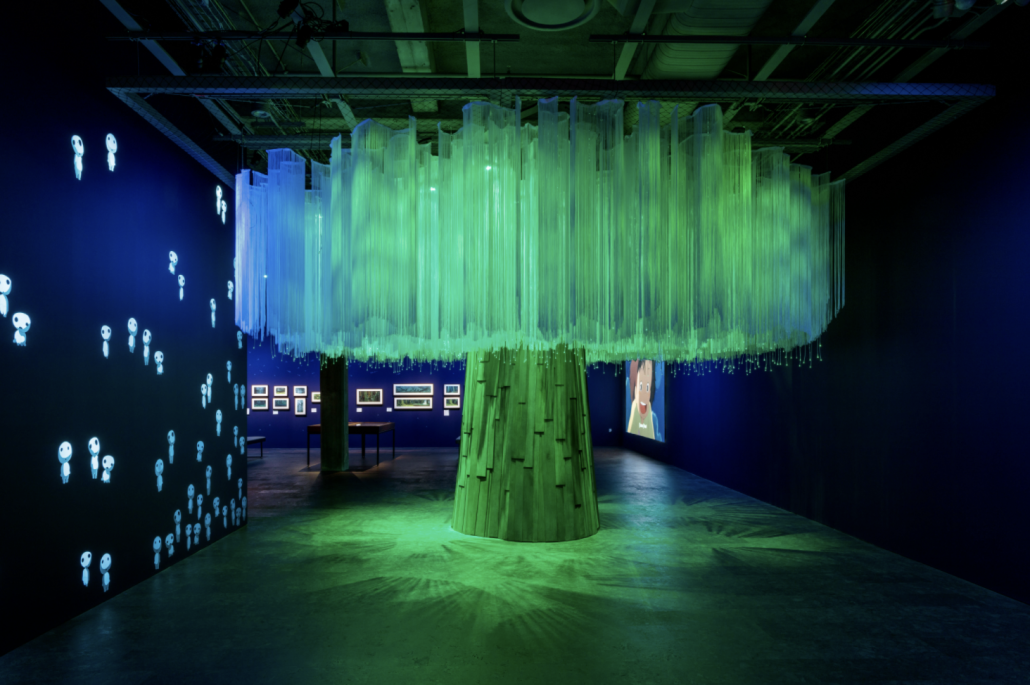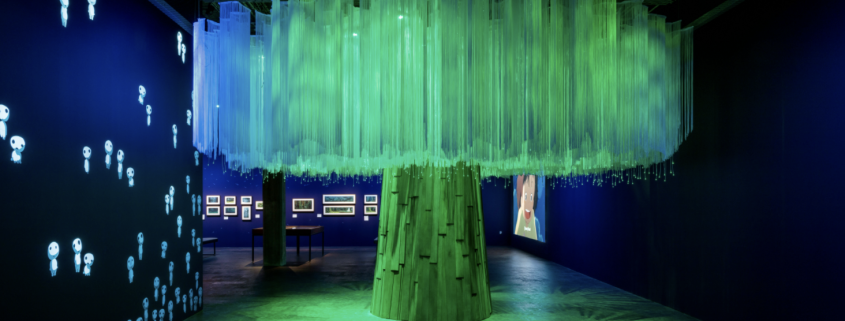Accept an Oscar at the Academy Museum

Designed by Pritzker Prize-winning architect Renzo Piano, the new 300,000-square-foot Academy Museum of Motion Pictures at the corner of Wilshire and Fairfax is a wonderful hub honoring the arts and sciences of film itself. The opening press event held on Sept. 21 included opening remarks from a slew of accomplished actors, executives and Piano himself, as well as opportunities to tour all of the exhibits and meet curators and screenings of selected shorts. Attendees were given the full museum experience. Opening Sept. 30 to the general public, the museum — which could become a sightseeing must in Los Angeles — will allow people to appreciate the process and behind-the-scenes efforts of filmmaking.
Named after Sidney Poitier, the entrance and main lobby of the museum includes the gift shop and Fanny’s, a restaurant and cafe named after Barbara Streisand’s Oscar-winning character in “Funny Girl”(1968). The idea for this museum has been a work in progress for a long time coming.
“Since 1929, when the first Academy board and its president Douglas Fairbanks dreamt of a museum devoted to motion pictures, our governors through the decades have sought to realize that dream,” said David Rubin, president of the Academy.
As this vision became closer to becoming a reality, numerous individuals, corporations, foundations and government entities came together to build the museum.
“I wanted to support the Academy Museum to remind future generations of the legends who have paved the roads for all of us,”Oprah Winfrey said in a video shown during the opening remarks of the press conference highlighting benefactors of the museum. “When I heard that the main lobby of the museum was going to be named for Sidney Poitier, I wanted to just shout for joy because, he is not only a personal hero, he’s a hero for the Academy, the first Black man to win an Oscar before there was even a Civil Rights Act, and he just so deserves to have that space be an honor to his name.”
“Stories of Cinema,” the museum’s core exhibit designed by WHY architecture, is primarily divided between the Spielberg Family Gallery and the Wanda Gallery on the first and second floors of the museum, culminating in the Rolex Gallery on the third floor. From costuming to casting, props and set design and every little detail in between that makes up the motion pictures that audiences enjoy on the screen, the museum has it all.
One of the most aesthetically charming exhibits, is the limited-time exhibition “Hayao Miyazaki,” in honor of the renowned animator and co-founder of animation powerhouse Studio Ghibli, known for “My Neighbor Totoro” (1988), “Kiki’s Delivery Service” (1989), “Spirited Away” (2001), “Howl’s Moving Castle” (2004) and “Ponyo” (2008). With a blue-green color palette that is soft on the eyes, the exhibit, located in the Marilyn and Jeffrey Katzenberg Gallery, offers insight into the intricate paintings made with acrylic poster paint or watercolor that were eventually carefully transformed into animations. The exhibit is definitely a must-see, considering that many of the images have never previously been diplayed beyond Japan.
The exhibit, designed with the idea of a kid-friendly environment, reflects the themes of Studio Ghibli Films.
“From early on, the tutorial content and design was completely intertwined. And the product was a byproduct of that relationship,” said Shraddha Aryal, vice president of exhibition design and production at the museum. “It’s undulating, it’s organic, it’s fun. We had very much kids in mind, [a] tactile quality to it.”
Whether one is older, younger or somewhere in between, the Hayao Miyazaki exhibit somehow manages to feel modern and nostalgic all at once.
A very refreshing component of the museum is the acknowledgement of diversity in filmmaking.
“As someone who has been dedicated to elevating the film industry in Korea, I’m proud of the truly international view of movies and movie makers that is built into the academy museum,” said Miky Lee, vice-chair of the Academy Museum’s Board of Trustees. “Now, the Academy Museum is giving the public an unprecedented opportunity to connect at any time with experiences of people everywhere, as seen through their films.”
The continuation of the “Stories of Cinema” exhibit in the Rolex Gallery provides a space for highlighting an accomplished and well-rounded roster of international filmmakers. Beginning with the works of Pedro Almodóvar, the exhibit is not only extremely well-designed with bright, modern colors, but also includes 12 screens that feature a significant theme or scene from the award-winning director’s notable work. The exhibit as a whole is an opportunity for viewers to learn more about filmmaking outside of the United States.
“The Path to Cinema: Highlights from the Richard Balzer Collection,” an exhibit filled with a wide variety of optical toys and pre-cinematic devices, especially impressed Academy Trustee and actor Tom Hanks.
“In the past, that was the power of a projected image that told some story in a dark room, that made people like all of us want to go inside that dark room and be transported to another place,” Hanks said. “ That’s what motion pictures do, I think, every single one of us can remember, not just a movie that moved us, but also the theater that we saw it in, where it was located.”
As thrilling as the world of Hollywood and entertainment often seems, the film industry has its fair share of issues from lack of diversity to workplace harassment. The Academy Museum addresses these topics, displaying panels about Black Lives Matter, sex-based discrimination and the #MeToo movement, while also providing multiple examples of films to watch to encourage further education on these topics such as “Bombshell” (2019), “The Invisible War” (2012) and “I Am Not Your Negro” (2016).
The museum evidently does not shy away from tough conversations and ensures that the right stories are shared with the public. One exhibit, “Backdrop: An Invisible Art,” is a 34-foot double-height installation that displays the painting of Mount Rushmore used in “North by Northwest” (1959).
While the sheer grandeur and size of this presentation is quite breathtaking and makes for a nice photo spot, the Academy museum addresses Mount Rushmore’s controversial and painful history. With an exhibit description titled “Wamaka Ogna Ke Icante” (The Heart of Everything That Is), the museum educates the attendees on the historical oppression of Indigenous people that is tied to the National Memorial, especially because for the Lakota community, Mount Rushmore desecrates their sacred land.
Arguably, the magnum opus of the museum is “The Oscars Experience” in the East West Bank Gallery where attendees can first hand experience the thrill of winning a coveted Academy Award with the purchase of a separate $15 ticket on top of general admission. With simulations to portray the famous Dolby Theatre where the best of filmmaking convenes every year, one can hold a real, eight and a half pound Oscar trophy, finishing the experience with a high-quality, multi-angular, memorable video being sent right to their inbox minutes later.
It is a thrilling experience, especially for those who hope to one day see themselves on the real awards stage. I was lucky enough to win the award for Best Director (for my unreleased, coming-of-age indie film), but perhaps you could win for Best Adapted Screenplay or Best Animated Feature.
Built in L.A., the epicenter of filmmaking, visiting the Academy Museum of Motion Pictures is a one-of-a-kind, transformative experience that has something of interest for every film enthusiast. By acknowledging the diversity at the forefront of popular cinema and also the accomplishments and advances of the past, this museum is an inclusive and educational space that offers something very special to L.A. and film enthusiasts globally.
It could be a major source of inspiration for directors, writers, actors, cinematographers, executives, musicians, costume designers and more, everywhere. The attention to accessibility and detail in every aspect of the museum’s design leads to multifaceted conversations that are more than necessary in the art of filmmaking. The world of cinema is special because it has the power to make audiences feel something, and this museum is a way to make visitors from all over the world feel something very special.

